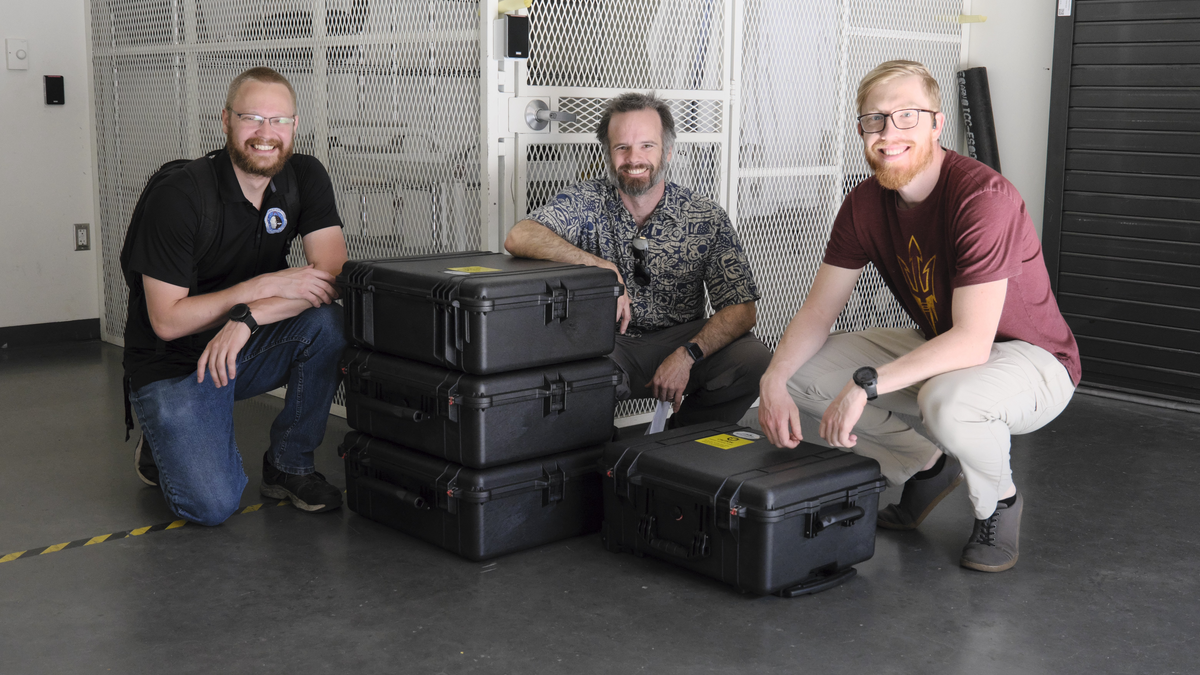SPARCS mission spacecraft bus delivered to ASU for final assembly

SPARCS mission team members (from left) Nathaniel Struebel, Daniel Jacobs, Logan Jensen receive the spacecraft bus. Courtesy photo
The Arizona State University team that is building the NASA-funded Star-Planet Activity Research CubeSat, or SPARCS, cleared a major milestone this week — receiving its spacecraft bus at the School of Earth and Space Exploration on the Tempe campus.
“We’ve been looking forward to this day for a long time. The telescope and ultraviolet camera, together called the payload, are assembled and being tested. Now that we have the bus, which is a chassis that holds everything and comes with the avionics and solar panels, we can put all the pieces together,” said Professor Evgenya Shkolnik, the mission’s principal investigator.
Mission co-investigator, Professor Daniel Jacobs, reports that now the mission can move into the final assembly and testing phase. The spacecraft bus will be tested and telescope payload installed. This testing will include the ground operations systems, which will be used by ASU students and faculty.
SPARCS will follow in the footsteps of other space instruments and probes originating from the School of Earth and Space Exploration — the OSIRIS-REx Thermal Emission Spectrometer, which arrived at the asteroid Bennu in August 2018; LunaH-Map (to measure lunar hydrogen as a proxy for water); the Europa Thermal Emission Imaging System (to seek temperature anomalies on Jupiter's moon Europa); the Lucy Thermal Emission Spectrometer (to measure surface properties among Jupiter's family of trojan asteroids); and Psyche, a mission to study an asteroid rich in nickel and iron.
Testing and flight operations are also supported by ASU’s Interplanetary Lab. Students and staff at the lab have designed and built portions of the flight and ground systems, provided environment testing and staffed operations.
“The team is working wonderfully together pushing the entire system to completion,” Shkolnik said.
Similar to other ASU CubeSat missions, SPARCS is a “6U” spacecraft — a small (only 30x20x10 centimeters in size) but dedicated space telescope.
The telescope uses a mirror system with coatings optimized for ultraviolet light. Together with the ultraviolet-sensitive camera, the system can measure small changes in the brightness of the high-energy emission from low-mass stars, the dominant hosts of exoplanets, to carry out the primary science of the mission.
The SPARCS science mission will monitor the flares and sunspot activity of low-mass stars of M and K spectral type, in the far- and near-ultraviolet, to assess how habitable the space environment is for planets orbiting these kinds of stars.
A key part of the mission is to train future engineers, scientists and mission leaders. SPARCS involves many ASU graduate students, undergraduate students and postdoctoral scholars in various roles.
Joining ASU in the SPARCS mission are scientists from the University of Washington, the University of Arizona, Lowell Observatory, the Southwest Research Institute, MIT, Goddard Space Flight Center, and NASA's Jet Propulsion Laboratory.
The SPARCS mission will be ready for launch at the end of 2024 and will be part of a rideshare to a Sun-synchronous low-Earth orbit in 2025.
More Science and technology

Cracking the code of online computer science clubs
Experts believe that involvement in college clubs and organizations increases student retention and helps learners build valuable social relationships. There are tons of such clubs on ASU's campuses…
Consortium for Science, Policy & Outcomes celebrates 25 years
For Arizona State University's Consortium for Science, Policy & Outcomes (CSPO), recognizing the past is just as important as designing the future. The consortium marked 25 years in Washington, D…

Hacking satellites to fix our oceans and shoot for the stars
By Preesha KumarFrom memory foam mattresses to the camera and GPS navigation on our phones, technology that was developed for space applications enhances our everyday lives on Earth. In fact, Chris…
